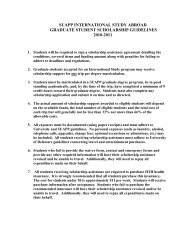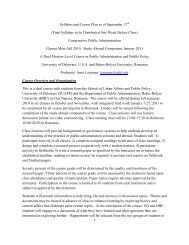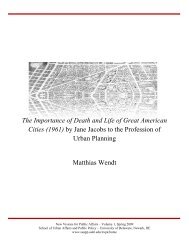New Visions for Public Affairs Volume 1 - School of Public Policy ...
New Visions for Public Affairs Volume 1 - School of Public Policy ...
New Visions for Public Affairs Volume 1 - School of Public Policy ...
You also want an ePaper? Increase the reach of your titles
YUMPU automatically turns print PDFs into web optimized ePapers that Google loves.
Mead, Hilary Bringing Equity Back 2<br />
Rather, equity has to be pursued consistently in the<br />
attempt to create a more just society” (p.12).<br />
Since equity is a shifting target and a constant struggle,<br />
it is important to consider education re<strong>for</strong>ms within<br />
their historical, political, social and economic contexts.<br />
The book‟s dominant narrative – framed by the editors<br />
and echoed within each article – is <strong>of</strong> a movement from<br />
the 1960s to 2005 and from “equity” to “excellence” as<br />
a guiding vision. This shift in discourse mirrors other<br />
changes in American political, economic and<br />
community culture. As Petrovich (2005) describes the<br />
progression:<br />
“Policies pursuing equity in education<br />
traditionally have favored a more fair<br />
distribution <strong>of</strong> educational access,<br />
opportunities and resources . . . . Such<br />
redistributive policies have been less<br />
important to those arguing <strong>for</strong> greater<br />
“excellence” in education. Instead they<br />
advocate a free-market approach to<br />
education that allows parents to choose<br />
schools <strong>for</strong> their children and <strong>for</strong>ces<br />
schools to improve so they can effectively<br />
compete <strong>for</strong> students. Faith in the private<br />
sphere rather than in government and the<br />
confidence <strong>of</strong> market mechanisms to<br />
improve efficiency and quality are<br />
replacing values <strong>of</strong> social solidarity, trust<br />
in public institutions [and citizenship]”<br />
(p.4).<br />
This means re<strong>for</strong>ms like affirmative action,<br />
desegregation, bilingual education and special<br />
education have been reduced or cast aside in favor <strong>of</strong><br />
charter schools, vouchers, school “report cards,” and<br />
standardized tests. This narrative closely matches what<br />
Oakes and Lipton (1999) call “the market metaphor”<br />
<strong>for</strong> education, which became dominant in the United<br />
States in the 1980s (p.23) and is also reflected in the<br />
standards movement, especially No Child Left Behind.<br />
This perspective assumes that choice and competition<br />
propels schools to new levels <strong>of</strong> quality. Then it is up to<br />
the student and family to take advantage <strong>of</strong> the<br />
opportunities theoretically available to them. Again in<br />
the book‟s language, there is a conflation between the<br />
end goal <strong>of</strong> “excellence” (i.e., high-quality education)<br />
with the strategies used to accomplish it (i.e. choice,<br />
competition, individual agency).<br />
Although they all agree on the historical trajectory from<br />
“equity” to “excellence,” these authors frame the<br />
relationship between these concepts somewhat<br />
differently. Clarke et al. (2005) portray them as held in<br />
a fragile balance, as does Petrovich (2005): “achieving<br />
an excellent education <strong>for</strong> all children requires policies<br />
and practices that address both quality and equity”<br />
(p.12-13). Considering economic resources and<br />
political capital, Gittell (2005) takes a different stance:<br />
“although advocates <strong>for</strong> excellence and equity declare<br />
their support <strong>for</strong> both goals, when translated into public<br />
policy the two concepts are <strong>of</strong>ten competitive” (p.24).<br />
Puriefoy (2005) expresses a clear vote <strong>for</strong> which is<br />
more important: “equity is the necessary precondition<br />
<strong>for</strong> academic excellence, <strong>for</strong> systemic school<br />
improvement and <strong>for</strong> the nation‟s democratic way <strong>of</strong><br />
life” (p.325). To the extent they emphasize equity over<br />
excellence; these authors aim to adjust the country‟s<br />
current obsession with excellence and to raise serious<br />
concerns about it. They provide evidence that (1)<br />
<strong>New</strong> <strong>Visions</strong> <strong>for</strong> <strong>Public</strong> <strong>Affairs</strong> – <strong>Volume</strong> 1, Spring 2009<br />
<strong>School</strong> <strong>of</strong> Urban <strong>Affairs</strong> and <strong>Public</strong> <strong>Policy</strong> – University <strong>of</strong> Delaware, <strong>New</strong>ark, DE<br />
www.suapp.udel.edu/nvpa/home







